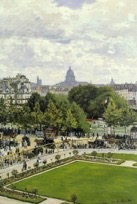 “Garden of the Princess, Louvre”, 1867 French Art – Mia Feigelson Gallery
“Garden of the Princess, Louvre”, 1867 French Art – Mia Feigelson Gallery
Monet at the Exhibition ‘Origins of Impressionism’ held at The Metropolitan Museum of Art, New York from 27 September 1994 through 8 January 1995
Watch an interview with Philippe de Montebello, Curator of the Exhibition and Director of The Met from 1977 to 2008 http://bit.ly/2Y6fPHp
Exhibition Catalogue by Gary Tinterow and Henri Loyrette – Foreword by Philippe de Montebello and Irène Bizot
Read the Exhibition Catalogue online or download the PDF for free http://bit.ly/32HdYME
Gallery: The Realist Landscape
“Garden of the Princess, Louvre”, 1867
By Claude Monet (French, 1840-1926)
oil on canvas; 91.8 x 61.9 cm (36 1/8 x 24 3/8 in.)
© Allen Memorial Art Museum, Oberlin, Ohio, US
R. T. Miller Jr. Fund, 1948 http://bit.ly/2IIowTt
https://www.facebook.com/allenartmuseum
Dr Andria Derstine, John G.W. Cowles Director of the Allen Memorial Art Museum, discusses the present work. Watch the Video here http://bit.ly/2q4Xak3
Overview:
“Garden of the Princess was painted from the colonnade of the Louvre in the spring of 1867, at the time of the opening of the Exposition universelle where Japanese art created widespread interest. Garden of the Princess presents random social groupings within a complex urban space, with interwoven trees and buildings.
Monet’s distant Pantheon is sharply defined and the chimney pots in the middle distance are as sharp as the trunks of the regimented rosebushes in the garden below. Monet looked down steeply onto the lawn below the Louvre, representing it as an absolutely flat, unmodulated plane of green paint.
Monet’s selective focus on certain figures — such as the couple or the nursemaid in the garden, or the woman in a pink dress caught by a gleam of light under the trees — gives a sense of human presence within the distantly observed urban crowd. He may have developed this mode of representation from Hiroshige’s witty abbreviated signs for different types of figures — an appropriate vocabulary for the disjointed experience of metropolitan Paris.
The Japanese artist, however, did not have Monet’s facility to use oil paint to suggest the crowd from which individual figures momentarily emerged.
Monet would have seen contemporary photographs of Paris streets taken from high buildings, but these could not have given him the experience of the eye’s active participation in the myriad visual moments of the modern city. He was less interested in the view than in his own visual sensations, high above an animated crowd in central Paris. Japanese prints helped him to embody these sensations.” – See more at http://bit.ly/33pkiYG




